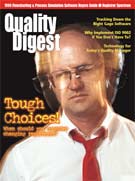 Tough Choices
Tough Choices
I just wanted to drop you a note to let you know how much I enjoy reading your articles in Quality Digest. I used to receive Quality Digest
a few years ago, but when I made a job change I stopped getting it. Then, the other day, my associate gave me the November 1999 issue for Phillip C. Dobyns and Jill C.
Smolnik's article on "Tough Choices," which is related to a current project of mine. Right away I found myself reading your article on
black belts and decided that this is one magazine that I want to renew. I really enjoy Quality Digest because it is down-to-earth, and I find it is
well-suited to my management education. I enjoy the leadership and personnel-related articles much more than the highly technical information provided by other magazines.
Please keep the articles coming. --Bob Sommerdorf
Quality Engineer
SPX Corp.  Quality Management Quality Management
Thank you for A. Blanton Godfrey's December 1999 column "Building a Scorecard," which clearly explains the importance of linking this tool to the organization's
strategic plan. I have been working with this tool for the Central Plains VA Healthcare Network in Nebraska and Iowa. I certainly agree with your format. Regarding
the use of weights in creating a balanced scorecard: Because we are just starting out, we have decided not to add weights to each measure--we believe that everything on the scorecard is
equally important. Our plan is to set goals and benchmarks to achieve, using these as our measures of success.
As a health care organization, we have selected the following domains of value/drivers, which tie in with our national and local strategic plans: quality of
care, access, customer satisfaction, cost efficiency, learning and growth (employee), and patient functional status. --Carol A. Keller
Performance Improvement Coordinator
Omaha VA Medical Center Non-Normal Distributions in the Real World
As an aspiring statistician, quality consultant and six-sigma trainer, I have enjoyed many of Thomas Pyzdek's articles and referenced more than one of his
books over the years. I really appreciated his December 1999 article in Quality Digest. The discussion was very well-developed, and the warning will, I hope, be heeded.
There are too many statisticians willing to trust the math they've learned. Walter A. Shewhart said that if we find a mathematical model that clashes with the
physical world, we have to find a new mathematical model, because the physical world is what we are stuck with. I have seen a number of papers that ignore this
principle; Pyzdek's article reiterates and reinforces it. I am going to keep this article among my most-used references.
Pyzdek points out in his example for PCA: "The lesson here is that it's counterproductive to use statistics by rote, blindly plugging numbers into
formulas and accepting the results. Plot a histogram of the data after you've attained statistical control, and think about how the histogram pattern relates to
the real world." This is super advice. He then recommends a Johnson curve translation, which makes an approximation of a CPI possible.
I guess my concern is that we seem to spend a lot of time and complexity on some of these capability studies. Although I can appreciate them for their
predictive power, I am well-versed enough to understand the limits of that same predictive power. The language of Cp and Cpk seems to have taken on a
magical aura for some managers who know little more about them other than that they want them to be bigger than one, if possible. I sometimes wonder if the
time we spend doing transformations and so on would not be better spent teaching managers the implications of the control charts and histograms and
teaching them "to think about how the histogram relates to the real world." Don't get me wrong… The Johnson curve technique seems to produce
reasonable estimates. I just worry about some managers who take the numbers we give them too literally and don't understand the uncertainty inherent in them. --Rip Stauffer
BlueFire Partners
(formerly Process Management International) Six Sigma and Beyond
Kindly help me to understand the six sigma concept as it relates to the 1.5 sigma shift that Motorola espouses. It is the mathematics or statistics that I do not
understand. Please give me a very elementary explanation of this concept. (Name withheld) Thomas Pyzdek responds:
The simple explanation is that Motorola believes that a process will drift ±1.5 standard deviations over the long term. Thus, they subtract 1.5 sigma
to determine the long-term process yield. For example, if a process is operating at 6 sigma, Motorola would compute the yield not as 2
parts-per-billion, as you'd get from consulting a table of the normal distribution, but 3.4 parts-per-million. The 3.4 ppm can be found in a
normal distribution table corresponding to 4.5 sigma, or 6 sigma less 1.5 sigma. This topic was discussed in greater depth in an article entitled "Six Sigma
Strategies: Creating Excellence in the Workplace" by Mario Perez-Wilson (Quality Digest, Dec. 1997). Great column in the November issue of
Quality Digest. This is the direction quality must go in the future. I have listened to Tom Peters preach for a number
of years that "Things gone right are as important, if not more important, than things gone wrong," but management at my company has always looked at that
as a radical idea. My hope is now that quality professionals like Thomas Pyzdek are writing about these things, they will finally be taken seriously.
Great job; keep pushing the edge. --Bob Giddings Letters to the editor are one of the few tools publications have to get
feedback from subscribers. Space constraints prevent us from publishing all of the letters we receive. E-mail your letters to letters@qualitydigest.com. |